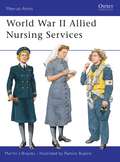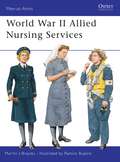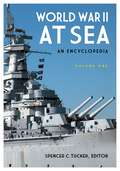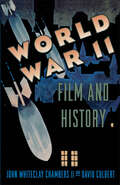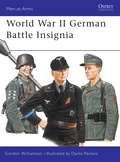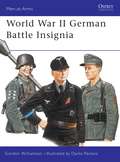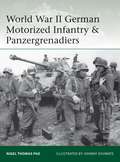- Table View
- List View
World War II Allied Nursing Services (Men-at-Arms)
by Ramiro Bujeiro Martin BrayleyThe skill and care of the women of the Allied military nursing services was remembered gratefully by hundreds of thousands of wounded servicemen. The small peacetime services increased rapidly by enrolling reservists and volunteers; the great majority of the nurses who cared for Allied casualties were 'civilians in uniform', who worked tirelessly under difficult conditions and in tented hospitals close to the front lines in real danger; many nurses paid for their devotion with their lives. This first-ever fully illustrated study of the US, British, Commonwealth, and other nursing organisations includes many unpublished photographs and 24 meticulously illustrated colour figures.
World War II Allied Nursing Services (Men-at-Arms #370)
by Ramiro Bujeiro Martin BrayleyThe skill and care of the women of the Allied military nursing services was remembered gratefully by hundreds of thousands of wounded servicemen. The small peacetime services increased rapidly by enrolling reservists and volunteers; the great majority of the nurses who cared for Allied casualties were 'civilians in uniform', who worked tirelessly under difficult conditions and in tented hospitals close to the front lines in real danger; many nurses paid for their devotion with their lives. This first-ever fully illustrated study of the US, British, Commonwealth, and other nursing organisations includes many unpublished photographs and 24 meticulously illustrated colour figures.
World War II Allied Sabotage Devices and Booby Traps (Elite #184)
by Peter Dennis Gordon L. RottmanFollowing Churchill's directive to 'set occupied Europe ablaze,' the SOE and later its American sister organization, the OSS, were deployed across the continent. Outnumbered, surrounded and in great peril, these brave agents were armed with a wide variety of devices to help them achieve their objectives, including numerous pieces of sabotage equipment and cunning booby traps. This book examines these different pieces of equipment and the technicalities involved in deploying them effectively, as well as discussing the specialist equipment developed by Special Forces units, including the SAS Lewes Bomb. Touching on some of the stranger developments, such as explosives disguised as lumps of coal, the author goes on to describe the German clearance techniques that were developed to avoid these dangers. Complete with specially commissioned artwork and period diagrams together with detailed descriptions of the dangerous missions of Allied agents, this book is a fascinating insight into the secret war behind enemy lines.
World War II Allied Sabotage Devices and Booby Traps (Elite)
by Peter Dennis Gordon L. RottmanFollowing Churchill's directive to 'set occupied Europe ablaze,' the SOE and later its American sister organization, the OSS, were deployed across the continent. Outnumbered, surrounded and in great peril, these brave agents were armed with a wide variety of devices to help them achieve their objectives, including numerous pieces of sabotage equipment and cunning booby traps. This book examines these different pieces of equipment and the technicalities involved in deploying them effectively, as well as discussing the specialist equipment developed by Special Forces units, including the SAS Lewes Bomb. Touching on some of the stranger developments, such as explosives disguised as lumps of coal, the author goes on to describe the German clearance techniques that were developed to avoid these dangers. Complete with specially commissioned artwork and period diagrams together with detailed descriptions of the dangerous missions of Allied agents, this book is a fascinating insight into the secret war behind enemy lines.
World War II and the West It Wrought
by Mark Brilliant and David M. KennedyFew episodes in American history were more transformative than World War II, and in no region did it bring greater change than in the West. Having lifted the United States out of the Great Depression, World War II set in motion a massive westward population movement, ignited a quarter-century boom that redefined the West as the nation's most economically dynamic region, and triggered unprecedented public investment in manufacturing, education, scientific research, and infrastructure—an economic revolution that would lay the groundwork for prodigiously innovative high-tech centers in Silicon Valley, the Puget Sound area, and elsewhere. Amidst robust economic growth and widely shared prosperity in the post-war decades, Westerners made significant strides toward greater racial and gender equality, even as they struggled to manage the environmental consequences of their region's surging vitality. At the same time, wartime policies that facilitated the federal withdrawal of Western public lands and the occupation of Pacific islands for military use continued an ongoing project of U.S. expansionism at home and abroad. This volume explores the lasting consequences of a pivotal chapter in U.S. history, and offers new categories for understanding the post-war West. Contributors to this volume include Mark Brilliant, Geraldo L. Cadava, Matthew Dallek, Mary L. Dudziak, Jared Farmer, David M. Kennedy, Daniel J. Kevles, Rebecca Jo Plant, Gavin Wright, and Richard White.
World War II at Sea: A Global History
by Craig L. SymondsAuthor of Lincoln and His Admirals (winner of the Lincoln Prize), The Battle of Midway (Best Book of the Year, Military History Quarterly), and Operation Neptune, (winner of the Samuel Eliot Morison Award for Naval Literature), Craig L. Symonds has established himself as one of the finest naval historians at work today. World War II at Sea represents his crowning achievement: a complete narrative of the naval war and all of its belligerents, on all of the world's oceans and seas, between 1939 and 1945. Opening with the 1930 London Conference, Symonds shows how any limitations on naval warfare would become irrelevant before the decade was up, as Europe erupted into conflict once more and its navies were brought to bear against each other. World War II at Sea offers a global perspective, focusing on the major engagements and personalities and revealing both their scale and their interconnection: the U-boat attack on Scapa Flow and the Battle of the Atlantic; the "miracle" evacuation from Dunkirk and the pitched battles for control of Norway fjords; Mussolini's Regia Marina-at the start of the war the fourth-largest navy in the world-and the dominance of the Kidö Butai and Japanese naval power in the Pacific; Pearl Harbor then Midway; the struggles of the Russian Navy and the scuttling of the French Fleet in Toulon in 1942; the landings in North Africa and then Normandy. Here as well are the notable naval leaders-FDR and Churchill, both self-proclaimed "Navy men," Karl Dönitz, François Darlan, Ernest King, Isoroku Yamamoto, Erich Raeder, Inigo Campioni, Louis Mountbatten, William Halsey, as well as the hundreds of thousands of seamen and officers of all nationalities whose live were imperiled and lost during the greatest naval conflicts in history, from small-scale assaults and amphibious operations to the largest armadas ever assembled. Many have argued that World War II was dominated by naval operations; few have shown and how and why this was the case. Symonds combines precision with story-telling verve, expertly illuminating not only the mechanics of large-scale warfare on (and below) the sea but offering wisdom into the nature of the war itself.
World War II at Sea: A Global History
by Craig L. SymondsAuthor of Lincoln and His Admirals (winner of the Lincoln Prize), The Battle of Midway (Best Book of the Year, Military History Quarterly), and Operation Neptune, (winner of the Samuel Eliot Morison Award for Naval Literature), Craig L. Symonds has established himself as one of the finest naval historians at work today. World War II at Sea represents his crowning achievement: a complete narrative of the naval war and all of its belligerents, on all of the world's oceans and seas, between 1939 and 1945. Opening with the 1930 London Conference, Symonds shows how any limitations on naval warfare would become irrelevant before the decade was up, as Europe erupted into conflict once more and its navies were brought to bear against each other. World War II at Sea offers a global perspective, focusing on the major engagements and personalities and revealing both their scale and their interconnection: the U-boat attack on Scapa Flow and the Battle of the Atlantic; the "miracle" evacuation from Dunkirk and the pitched battles for control of Norway fjords; Mussolini's Regia Marina-at the start of the war the fourth-largest navy in the world-and the dominance of the Kidö Butai and Japanese naval power in the Pacific; Pearl Harbor then Midway; the struggles of the Russian Navy and the scuttling of the French Fleet in Toulon in 1942; the landings in North Africa and then Normandy. Here as well are the notable naval leaders-FDR and Churchill, both self-proclaimed "Navy men," Karl Dönitz, François Darlan, Ernest King, Isoroku Yamamoto, Erich Raeder, Inigo Campioni, Louis Mountbatten, William Halsey, as well as the hundreds of thousands of seamen and officers of all nationalities whose live were imperiled and lost during the greatest naval conflicts in history, from small-scale assaults and amphibious operations to the largest armadas ever assembled. Many have argued that World War II was dominated by naval operations; few have shown and how and why this was the case. Symonds combines precision with story-telling verve, expertly illuminating not only the mechanics of large-scale warfare on (and below) the sea but offering wisdom into the nature of the war itself.
World War II at Sea [2 volumes]: An Encyclopedia [2 volumes]
The war at sea was a key aspect of World War II, one that is too-often under-studied. This comprehensive encyclopedia shares current understandings of the struggle to control the seas during that conflict—and it opens our eyes to the reasons sea power continues to be of critical importance today.Scholarly treatment of World War II is constantly changing as new materials inform new interpretations. At the same time, current military operations lead to reevaluation of the tactics and technologies of the past. Marshalling the latest information and insights into this epic conflict, World War II at Sea: An Encyclopedia will enable students and other interested readers to explore specific naval engagements, while also charting the transformation of naval history through innovations in ordnance.In treating the naval aspects of World War II, this two-volume ready reference enhances the understanding of a part of the war that is often overshadowed by the fighting on land and in the air. The encyclopedia focuses on the events, individuals, organizations, and ideas that shaped the world's navies during World War II, as well as the resultant battles that changed naval history. It also covers the numerous innovations that occurred during the conflict and shows how strategies evolved and were executed.
World War II Axis Booby Traps and Sabotage Tactics (Elite)
by Peter Dennis Gordon L. RottmanBooby traps laid by troops in war zones in World War II are largely neglected in histories and memoirs, and rarely examined in detail. Yet for a soldier, the threat of booby traps had to be at the forefront of his mind, and an ability to find and disarm them was essential. This is the first comprehensive study of World War II's battlefield booby traps, using information from rare wartime intelligence publications to identify, illustrate and describe the tactics of both Allied and Axis saboteurs. Examining all aspects of this secretive subject, from the equipment used to the techniques of placing and finding them, this book uncovers the daily risks faced by soldiers on the ground through the course of the war.
World War II Axis Booby Traps and Sabotage Tactics (Elite #100)
by Gordon L. RottmanBooby traps laid by troops in war zones in World War II are largely neglected in histories and memoirs, and rarely examined in detail. Yet for a soldier, the threat of booby traps had to be at the forefront of his mind, and an ability to find and disarm them was essential. This is the first comprehensive study of World War II's battlefield booby traps, using information from rare wartime intelligence publications to identify, illustrate and describe the tactics of both Allied and Axis saboteurs. Examining all aspects of this secretive subject, from the equipment used to the techniques of placing and finding them, this book uncovers the daily risks faced by soldiers on the ground through the course of the war.
World War II Battle by Battle
by Nikolai BogdanovicThis compact gift book takes thirty of World War II's most significant clashes, both the famous and the lesser known, and presents their stories in a concise, easy to digest format, accompanied by beautiful Osprey artwork plates in full colour that illuminate a key moment in each battle.World War II was the single greatest conflict the world has ever known, fought in theatres all around the globe, and many of its battles – Stalingrad, Monte Cassino, the Battle of Britain – are household names. While the Western Front in Europe is often what first comes to mind, bitter and bloody battles were also fought in Eastern Europe, Africa, Asia and the Pacific, on land, at sea, and in the air, and their many stories help illuminate both the scale and the varying character of the conflict.
World War II Battle by Battle
by Nikolai BogdanovicThis compact gift book takes thirty of World War II's most significant clashes, both the famous and the lesser known, and presents their stories in a concise, easy to digest format, accompanied by beautiful Osprey artwork plates in full colour that illuminate a key moment in each battle.World War II was the single greatest conflict the world has ever known, fought in theatres all around the globe, and many of its battles – Stalingrad, Monte Cassino, the Battle of Britain – are household names. While the Western Front in Europe is often what first comes to mind, bitter and bloody battles were also fought in Eastern Europe, Africa, Asia and the Pacific, on land, at sea, and in the air, and their many stories help illuminate both the scale and the varying character of the conflict.
World War II Croatian Legionaries: Croatian Troops under Axis Command 1941–45 (Men-at-Arms)
by Vladimir Brnardic Višeslav AralicaAs Europe descended into war the newly formed state of Croatia found itself an ally in Nazi Germany. Tens of thousands of Croatians volunteered for the German Wehrmacht, with Croatian-badged units created within the Army, Navy, Luftwaffe, Waffen-SS and Police force. When Hitler turned his attention to Stalin's Soviet Union many of these men found themselves thrown into the fray, with Croatian soldiers serving at Stalingrad, fighting Tito's Partisans in the Balkans and battling against the advancing Red Army in Hungary. Aided by detailed illustrations, author Vladimir Brnardic explores the uniforms and equipment of World War II Croatian Legionaries.
World War II Croatian Legionaries: Croatian Troops under Axis Command 1941–45 (Men-at-Arms #508)
by Vladimir Brnardic Višeslav AralicaAs Europe descended into war the newly formed state of Croatia found itself an ally in Nazi Germany. Tens of thousands of Croatians volunteered for the German Wehrmacht, with Croatian-badged units created within the Army, Navy, Luftwaffe, Waffen-SS and Police force. When Hitler turned his attention to Stalin's Soviet Union many of these men found themselves thrown into the fray, with Croatian soldiers serving at Stalingrad, fighting Tito's Partisans in the Balkans and battling against the advancing Red Army in Hungary. Aided by detailed illustrations, author Vladimir Brnardic explores the uniforms and equipment of World War II Croatian Legionaries.
World War II Desert Tactics (Elite)
by Paddy Griffith Mr Adam HookFrom 1940 to 1943 North Africa saw the first major desert campaign by modern mechanised armies. The British, Italians, German Afrika Korps and US Army all addressed and learned from the special problems human, logistical, mechanical and tactical of the desert environment, most significantly fighting in a terrain empty of resources and offering little chance of concealment. Paddy Griffith traces the fast-learned development in armour, artillery and infantry tactics in this exceptional arena and illustrates them with references to the major engagements in the North African theatre, which involved some of the greatest tacticians of World War II in one of the pivotal theatres.
World War II Desert Tactics (Elite)
by Adam Hook Paddy GriffithFrom 1940 to 1943 North Africa saw the first major desert campaign by modern mechanised armies. The British, Italians, German Afrika Korps and US Army all addressed and learned from the special problems human, logistical, mechanical and tactical of the desert environment, most significantly fighting in a terrain empty of resources and offering little chance of concealment. Paddy Griffith traces the fast-learned development in armour, artillery and infantry tactics in this exceptional arena and illustrates them with references to the major engagements in the North African theatre, which involved some of the greatest tacticians of World War II in one of the pivotal theatres.
World War II Fighter Planes Spotter's Guide
by Tony HolmesWorld War II saw pilots from around the world battling in the skies over Europe, Asia and Africa, with victory resting upon their nerve, skill and the capabilities of some of history's most iconic aircraft. In the chaos of battle, it was vital that they could quickly identify friend from foe. But do you know your Hurricane from your Bf 109, or what the legendary P-51 Mustang looks like? Do you know the wingspan of the A6M Zero-sen, or how fast it could fly?THE WORLD WAR II FIGHTER PLANES SPOTTER'S GUIDE answers all of these questions and more, providing essential information on over 90 legendary aircraft, from the celebrated Spitfire to the jet-powered Me 262. Featuring full-colour artwork to aid recognition, as well as all the details you need to assess their performance, this is the perfect pocket guide to the Allied and Axis fighters of World War II
World War II Fighter Planes Spotter's Guide
by Tony HolmesWorld War II saw pilots from around the world battling in the skies over Europe, Asia and Africa, with victory resting upon their nerve, skill and the capabilities of some of history's most iconic aircraft. In the chaos of battle, it was vital that they could quickly identify friend from foe. But do you know your Hurricane from your Bf 109, or what the legendary P-51 Mustang looks like? Do you know the wingspan of the A6M Zero-sen, or how fast it could fly?THE WORLD WAR II FIGHTER PLANES SPOTTER'S GUIDE answers all of these questions and more, providing essential information on over 90 legendary aircraft, from the celebrated Spitfire to the jet-powered Me 262. Featuring full-colour artwork to aid recognition, as well as all the details you need to assess their performance, this is the perfect pocket guide to the Allied and Axis fighters of World War II
World War II, Film, and History
by John Whiteclay Chambers David CulbertThe immediacy and perceived truth of the visual image, as well as film and television's ability to propel viewers back into the past, place the genre of the historical film in a special category. War films--including antiwar films--have established the prevailing public image of war in the twentieth century. For American audiences, the dominant image of trench warfare in World War I has been provided by feature films such as All Quiet on the Western Front and Paths of Glory. The image of combat in the Second World War has been shaped by films like Sands of Iwo Jima and The Longest Day. And despite claims for the alleged impact of widespread television coverage of the Vietnam War, it is actually films such as Apocalypse Now and Platoon which have provided the most powerful images of what is seen as the "reality" of that much disputed conflict. But to what degree does history written "with lightning," as Woodrow Wilson allegedly said, represent the reality of the past? To what extent is visual history an oversimplification, or even a distortion of the past? Exploring the relationship between moving images and the society and culture in which they were produced and received, World War II, Film, and History addresses the power these images have had in determining our perception and memories of war. Examining how the public memory of war in the twentieth century has often been created more by a manufactured past than a remembered one, a leading group of historians discusses films dating from the early 1930s through the early 1990s, created by filmmakers the world over, from the United States and Germany to Japan and the former Soviet Union. For example, Freda Freiberg explains how the inter-racial melodramatic Japanese feature film China Nights, in which a manly and protective Japanese naval officer falls in love with a beautiful young Chinese street waif and molds her into a cultured, submissive wife, proved enormously popular with wartime Japanese and helped justify the invasion of China in the minds of many Japanese viewers. Peter Paret assesses the historical accuracy of Kolberg as a depiction of an unsuccessful siege of that German city by a French Army in 1807, and explores how the film, released by Hitler's regime in January 1945, explicitly called for civilian sacrifice and last-ditch resistance. Stephen Ambrose contrasts what we know about the historical reality of the Allied D-Day landings in Normandy on June 6, 1944, with the 1962 release of The Longest Day, in which the major climactic moment in the film never happened at Normandy. Alice Kessler-Harris examines The Life and Times of Rosie the Riveter, a 1982 film documentary about women defense workers on the American home front in World War II, emphasizing the degree to which the documentary's engaging main characters and its message of the need for fair and equal treatment for women resonates with many contemporary viewers. And Clement Alexander Price contrasts Men of Bronze, William Miles's fine documentary about black American soldiers who fought in France in World War I, with Liberators, the controversial documentary by Miles and Nina Rosenblum which incorrectly claimed that African-American troops liberated Holocaust survivors at Dachau in World War II. In today's visually-oriented world, powerful images, even images of images, are circulated in an eternal cycle, gaining increased acceptance through repetition. History becomes an endless loop, in which repeated images validate and reconfirm each other. Based on archival materials, many of which have become only recently available, World War II, Film, and History offers an informative and a disturbing look at the complex relationship between national myths and filmic memory, as well as the dangers of visual images being transformed into "reality."
World War II, Film, and History
by John Whiteclay Chambers David CulbertThe immediacy and perceived truth of the visual image, as well as film and television's ability to propel viewers back into the past, place the genre of the historical film in a special category. War films--including antiwar films--have established the prevailing public image of war in the twentieth century. For American audiences, the dominant image of trench warfare in World War I has been provided by feature films such as All Quiet on the Western Front and Paths of Glory. The image of combat in the Second World War has been shaped by films like Sands of Iwo Jima and The Longest Day. And despite claims for the alleged impact of widespread television coverage of the Vietnam War, it is actually films such as Apocalypse Now and Platoon which have provided the most powerful images of what is seen as the "reality" of that much disputed conflict. But to what degree does history written "with lightning," as Woodrow Wilson allegedly said, represent the reality of the past? To what extent is visual history an oversimplification, or even a distortion of the past? Exploring the relationship between moving images and the society and culture in which they were produced and received, World War II, Film, and History addresses the power these images have had in determining our perception and memories of war. Examining how the public memory of war in the twentieth century has often been created more by a manufactured past than a remembered one, a leading group of historians discusses films dating from the early 1930s through the early 1990s, created by filmmakers the world over, from the United States and Germany to Japan and the former Soviet Union. For example, Freda Freiberg explains how the inter-racial melodramatic Japanese feature film China Nights, in which a manly and protective Japanese naval officer falls in love with a beautiful young Chinese street waif and molds her into a cultured, submissive wife, proved enormously popular with wartime Japanese and helped justify the invasion of China in the minds of many Japanese viewers. Peter Paret assesses the historical accuracy of Kolberg as a depiction of an unsuccessful siege of that German city by a French Army in 1807, and explores how the film, released by Hitler's regime in January 1945, explicitly called for civilian sacrifice and last-ditch resistance. Stephen Ambrose contrasts what we know about the historical reality of the Allied D-Day landings in Normandy on June 6, 1944, with the 1962 release of The Longest Day, in which the major climactic moment in the film never happened at Normandy. Alice Kessler-Harris examines The Life and Times of Rosie the Riveter, a 1982 film documentary about women defense workers on the American home front in World War II, emphasizing the degree to which the documentary's engaging main characters and its message of the need for fair and equal treatment for women resonates with many contemporary viewers. And Clement Alexander Price contrasts Men of Bronze, William Miles's fine documentary about black American soldiers who fought in France in World War I, with Liberators, the controversial documentary by Miles and Nina Rosenblum which incorrectly claimed that African-American troops liberated Holocaust survivors at Dachau in World War II. In today's visually-oriented world, powerful images, even images of images, are circulated in an eternal cycle, gaining increased acceptance through repetition. History becomes an endless loop, in which repeated images validate and reconfirm each other. Based on archival materials, many of which have become only recently available, World War II, Film, and History offers an informative and a disturbing look at the complex relationship between national myths and filmic memory, as well as the dangers of visual images being transformed into "reality."
World War II For Dummies (For Dummies Ser.)
by Keith D. DicksonInvestigate the factors that led to war Examine key turning points, including D-Day and Hiroshima Get to know the opposing forces — the Allies and the Axis Explore the greatest war in history World War II was the most destructive conflict of the 20th century. How did it happen — and why? Packed with fascinating anecdotes, interesting sidebars, and top ten lists, this friendly reference contains everything you need to know about World War II, from the issues that caused the war to its most crucial confrontations and what happened in the aftermath. Read about important figures on both sides, study Hitler's war against the Jews, and find out how the Allies finally achieved victory. Whatever your interest, World War II For Dummies is your go-to guide. Inside … The significance of World War II Hitler's rise to power The invasion of Eastern Europe Pearl Harbor and U.S. neutrality Life and labor on the home front The Holocaust Liberation and what came next
World War II For Dummies
by Keith D. DicksonInvestigate the factors that led to war Examine key turning points, including D-Day and Hiroshima Get to know the opposing forces — the Allies and the Axis Explore the greatest war in history World War II was the most destructive conflict of the 20th century. How did it happen — and why? Packed with fascinating anecdotes, interesting sidebars, and top ten lists, this friendly reference contains everything you need to know about World War II, from the issues that caused the war to its most crucial confrontations and what happened in the aftermath. Read about important figures on both sides, study Hitler's war against the Jews, and find out how the Allies finally achieved victory. Whatever your interest, World War II For Dummies is your go-to guide. Inside … The significance of World War II Hitler's rise to power The invasion of Eastern Europe Pearl Harbor and U.S. neutrality Life and labor on the home front The Holocaust Liberation and what came next
World War II German Battle Insignia (Men-at-Arms)
by Darko Pavlovic Gordon WilliamsonThe remarkable war effort of the German armed forces on three fronts between 1939 and 1945 was recognised by a wider range of insignia than seen in the Allied armies. While the Wehrmacht displayed fewer unit insignia than the Allies, a glance at a German soldier's tunic could reveal much more about his actual combat experience. In this book an experienced researcher explains and illustrates the Battle and Assault Badges of the Army, Waffen-SS and Luftwaffe ground troops; the sleeve shields and cuffbands issued to mark service in particular campaigns; wound badges, commemorative medals, and other types of insignia.
World War II German Battle Insignia (Men-at-Arms #365)
by Darko Pavlovic Gordon WilliamsonThe remarkable war effort of the German armed forces on three fronts between 1939 and 1945 was recognised by a wider range of insignia than seen in the Allied armies. While the Wehrmacht displayed fewer unit insignia than the Allies, a glance at a German soldier's tunic could reveal much more about his actual combat experience. In this book an experienced researcher explains and illustrates the Battle and Assault Badges of the Army, Waffen-SS and Luftwaffe ground troops; the sleeve shields and cuffbands issued to mark service in particular campaigns; wound badges, commemorative medals, and other types of insignia.
World War II German Motorized Infantry & Panzergrenadiers (Elite)
by Johnny Shumate Nigel ThomasIn World War II Germany's doctrine of mobile warfare dominated the battlefield. By trial and error, the Germans were the first to correctly combine the strength in tanks and in mobile infantry and artillery. This integration of mobile units, equipment and tactics underpinned Germany's successes in the first half of the war. As the war dragged on, the Allies sought to copy German tactics but German armies remained supreme in this type of warfare until their losses had seriously degraded their capabilities. This study traces the development of the different types of unit that came together in the Panzergrenadier branch from the inter-war years through World War II. Using colour plates to display the changes in uniform, equipment and insignia in all theatres of operations throughout the conflict, this is a complete account of Hitler's elite armoured infantry.
